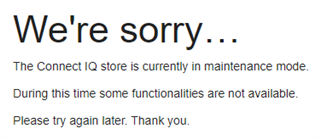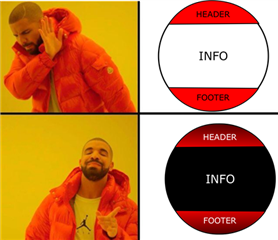The app store database update has been completed successfully. You should now be able to upload new apps and update existing apps without issue. Thank you for your patience while the maintenance was completed.
The app store database update has been completed successfully. You should now be able to upload new apps and update existing apps without issue. Thank you for your patience while the maintenance was completed.
Due to issues discovered after the update we will be extending the app store maintenance. During this time, there will be no impact on Connect IQ end users, but developer app uploads and updates have been temporarily disabled. We will provide updates via this post on the progress. We are working to resolve this as quickly as possible so you can share your creations. Thank you for your patience as we work to get this resolved.
We're in the process of doing some app store database maintenance, for which we've needed to temporarily disable app uploads and app updates:

We expect to have things back to normal later today, and there should be no impact on typical Connect IQ users. Apologies for the inconvenience!
Hello,
We've released SDK 3.1.5 which includes device support and version changes, as well as some minor updates. Here is a list of some of the changes and updates:
General Changes
Simulator Changes
Compiler Changes
Hello,
We've released SDK 3.1.4 which includes a few bug fixes and some minor updates. Here is a list of some of the things we've done:
General Changes
Simulator Changes
Compiler Changes
At long last Connect IQ 3.1 is here! Here are some of the new features it brings to the table:
You may have noticed we also launched some products the past few weeks. I’d like to take a moment to talk you through some of the products and new features.
vívoactive® 4/4S – The vívoactive 4 and 4S are the natural continuation of the vívoactive line. There are two sizes (small and regular) both of which have the latest Elevate sensors and support music. The one button version has been updated to have two buttons on the right side; one for start/stop and another for back.
fēnix® 6S/6 – The fēnix 6s/6 are successors to the fēnix 5 series. There are two sizes (small and regular) with the latest Elevate sensors.
fēnix 6S/6/6X Pro – The fēnix 6s/6/6X Pro are successors to the fēnix 5 Plus series. There are three sizes (small, regular, and Shaq) with the latest Elevate sensors and all support music. The 6X Pro Solar adds a solar cell to allow charging while operating outside.
Venu – The Venu is a new variant of the vívoactive 4. In addition to the latest Elevate sensors and music, the Venu is the first Garmin wearable to feature an AMOLED screen. This is the most beautiful screen ever on a Garmin watch but introduces new considerations for your apps.
Legacy Series – These are vívoactive 4 and 4s units branded with Marvel content. For all intents and purposes consider them vívoactive 4 and 4s units.
Here is a technical breakdown of the devices:
|
Feature |
vívoactive 4S |
vívoactive 4 |
fēnix 6S |
fēnix 6S Pro |
fēnix 6 |
fēnix 6 Pro |
fēnix 6X Pro |
Venu |
|
Screen |
MIP |
MIP |
MIP |
MIP |
MIP |
MIP |
MIP |
AMOLED |
|
Resolution |
218x218 |
260x260 |
240x240 |
240x240 |
260x260 |
260x260 |
280x280 |
390x390 |
|
Icon |
36x36 |
43x43 |
40x40 |
40x40 |
40x40 |
40x40 |
40x40 |
40x40 |
|
Colors |
64 |
64 |
64 |
64 |
64 |
64 |
64 |
16 BPP |
|
Music |
Yes |
Yes |
No |
Yes |
No |
Yes |
Yes |
Yes |
|
Maps |
No |
No |
No |
Yes |
No |
Yes |
Yes |
No |
|
Inputs |
Touchscreen |
Touchscreen |
Buttons |
Buttons |
Buttons |
Buttons |
Buttons |
Touchscreen |
|
Widget Glances |
No |
No |
Yes |
Yes |
Yes |
Yes |
Yes |
No |
|
Watch Face RAM |
96K |
96K |
96 KB |
96K |
96 KB |
96K |
96K |
512 KB |
|
Data Field RAM |
32 KB |
32 KB |
32 KB |
128 KB |
32 KB |
128 KB |
128 KB |
32 KB |
|
Widget RAM |
512 KB |
512 KB |
64 KB |
1 MB |
64 KB |
1 MB |
1 MB |
512 KB |
|
App RAM |
1 MB |
1 MB |
128 KB |
1.25 MB |
128 KB |
1.25 MB |
1.25 MB |
1 MB |
|
Music RAM |
512 KB |
512 KB |
N/A |
512 KB |
N/A |
512 KB |
512 KB |
512 KB |
|
Glance RAM |
N/A |
N/A |
32 KB |
64 KB |
32 KB |
64 KB |
64 KB |
N/A |
|
Background RAM |
64 KB |
32 KB |
32 KB |
32 KB |
32 KB |
32 KB |
32 KB |
64 KB |
The fēnix 6 and Venu introduce some features we did not cover at Connect IQ summit that are only available in the 3.1 SDK. Lets talk about them briefly.
The fēnix 6 series introduces some changes for widgets that will permeate across the Connect IQ ecosystem. The widget loop is converting from a carousel to a list presentation, which will make it much faster for users to navigate their information. When the user clicks on your glance, it will launch into the foreground.
To support this new behavior, CIQ is introducing in 3.1 a new glance background type that allows your widget to update its glance presentation behind the scenes.
The Venu is the first Garmin watch with an AMOLED screen. Your apps now can have breathtaking presentations of information and gorgeous imagery, while still retaining days of battery life. However, now that we have given you all these gorgeous colors, could you, like, not use them?
Please?
Here is the challenge with AMOLED – every pixel draws power. If you want your apps to fall within the regular amount of battery life, you want to have as much black on screen as possible, especially in screens that are showing activity information. You’ll notice that with most of the native applications, black is the new black. It’s okay to work a periodic splash screen or gradient into your apps – make the app look great! – but for screens that are supposed to show constantly updating data, the blacker the better. Also, if you have header and footer gradients, try to have the darker parts at the outer edges.
Just remember this handy guide when doing app layouts for Venu:

Always On watch faces behave differently from MIP to AMOLED. With MIP screens, you can use View.onPartialUpdate to update a portion of the screen every second. With AMOLED screen, this is no longer allowed. Instead, when WatchUi.onEnterSleep is called, you are allowed to render a watch face that must obey the rules of the AMOLED burn-in
protector:
Ways you can prevent burn in are by drawing the time with a thin font, shifting the time every minute as not to repeatedly leave the same pixels on, and not having static tick marks that leave the same pixels on.
Note that watch faces can detect whether a product has screen protection enforced by checking the value of DeviceSettings.requiresBurnInProtection.
The default color depth for the Venu is 16 bits per pixel, similar to Edge products. If you do not use the <palette> option when importing resources, be aware that your images will grow in file size, and by proxy take a lot longer to download to the device. You can also add the attribute compress="true" to your image resources, with the trade offs that images may take longer to load and compression is not available on Connect IQ 1.x products.
New Features. Better Tools. New Devices. Get the SDK today and make your apps dance and sing.
Hello Developers and Users,
I'm happy to announce that we were able to get the iOS settings bug fixed in a hotfix release of the Garmin Connect App! This is great news for a few reasons. One, because settings are fixed. Two, because our users are happy and will stop emailing all of us! And finally, because we did it! We worked together and we were able to get things fixed quicker than our normal schedule. Just more proof that Connect IQ is indeed an important and growing piece in the larger Garmin ecosystem. So give yourselves a pat on the back and celebrate!
-The Connect IQ Team
Hello Developers and Users,
As many of you know by now, there were some changes that made their way into the Garmin Connect App on iOS that have caused a break in app settings. We were made aware of this issue and reported it immediately. Despite our best efforts to get the necessary changes made before the launch of 4.22, the bug continues to persist. For that, we are sorry. We understand that, not only does that break functionality for a specific set of our common users, it also generates quite a bit of email traffic for you as well.
We've done two things here to help mitigate this:
First, this forum post acknowledging and addressing the issue through an official Garmin source.
Second, we've communicated with our product support teams that this app settings issue on iOS is not an issue that can be addressed by you, our external developer community. In such, they have been instructed to advise customer complaints to utilize the Connect IQ Store App for iOS for settings changes and that there is no need to contact you, the developer, as this is an issue on the Garmin side of things. Users may need to uninstall and reinstall their affected CIQ content before using the Connect IQ Store App in order to remove a corrupted settings file. Our Product Support agents know to communicate this as well.
Our goal is to have this issue resolved within 1 release cycle or sooner. We can't guarantee a fix before the next normal release, but we will continue to push for greater priority.
Thank you for you patience and understanding,
-The Connect IQ Team
Connect IQ extraordinaire Jim Miller has written a Connect IQ/Raspberry Pi solution for making solutions that communicate over BLE.
Here is a look at everything in action:
Special thanks to Hermo Terblanche for help on this tutorial.
Hello Everyone!
In an attempt to stay up with the needs of our community we are addressing one of your continued requests. We are going to changing the reply structure in discussions. There are some things we have control of here, and other things that are limitations of the software that we are working on externally, but this one we can do.
This means that moving forward, all replies will simply be in line one after another. There will not be any "branched" replies. The newest post will always be the last. This will make things much more straightforward and in line with the way that most of you have requested.
A few things to note:
Thanks for all of your feedback and your patience as we figure out the best ways to use the community to suit the needs of our developers!
-Coleman